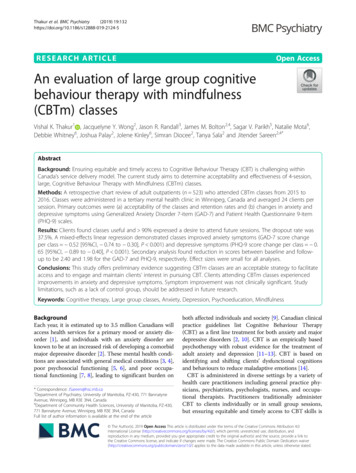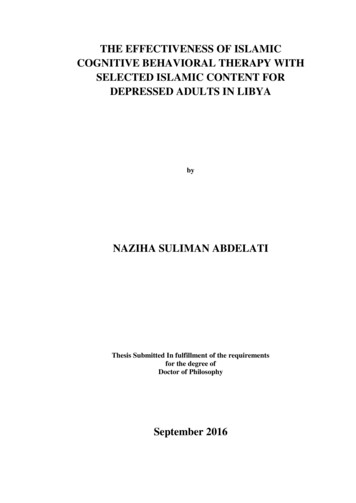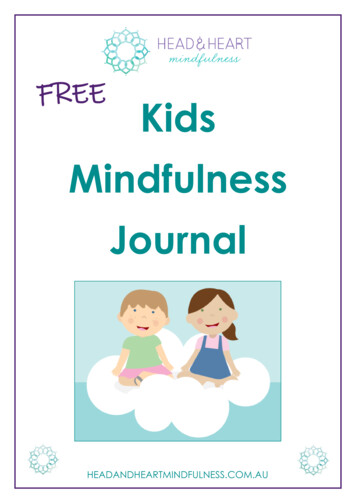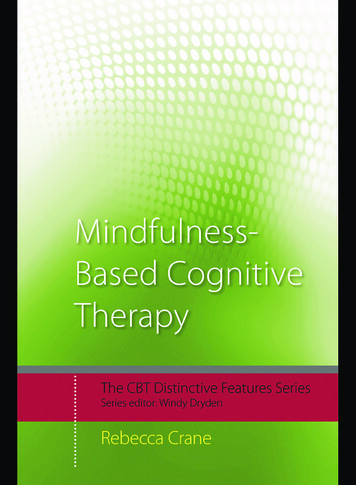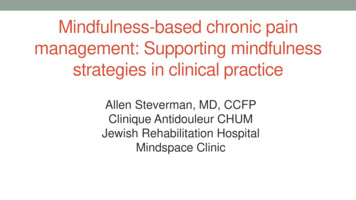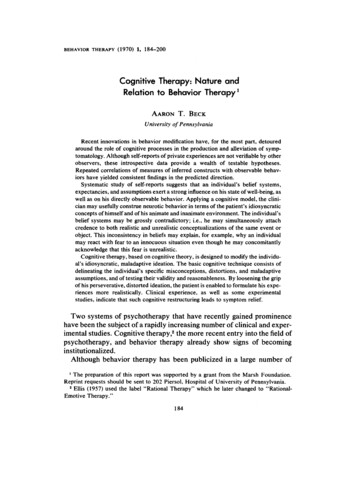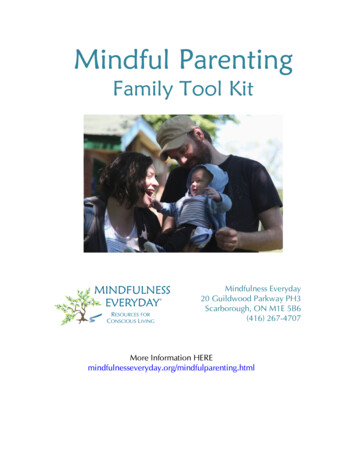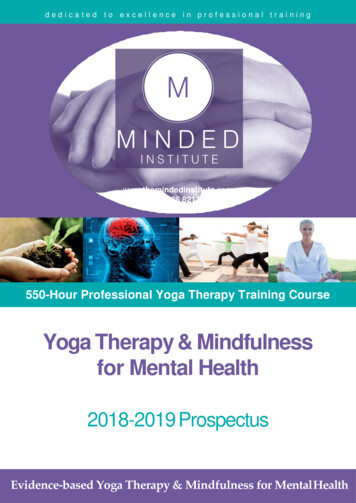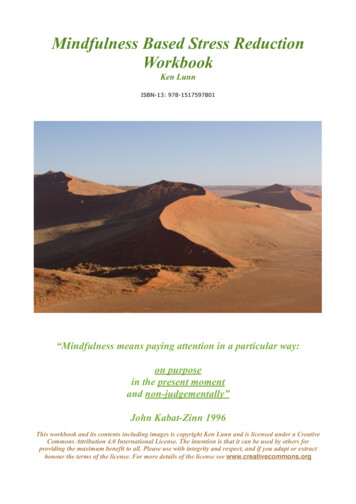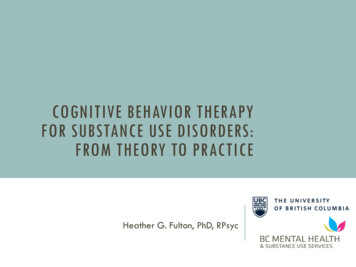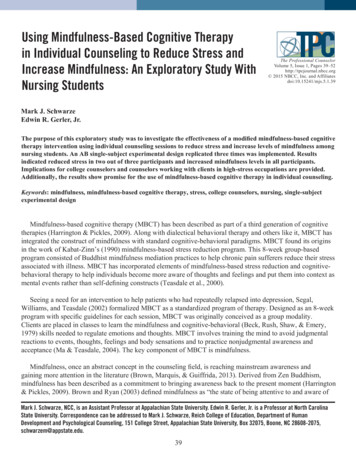
Transcription
Using Mindfulness-Based Cognitive Therapyin Individual Counseling to Reduce Stress andIncrease Mindfulness: An Exploratory Study WithNursing StudentsThe Professional CounselorVolume 5, Issue 1, Pages 39–52http://tpcjournal.nbcc.org 2015 NBCC, Inc. and Affiliatesdoi:10.15241/mjs.5.1.39Mark J. SchwarzeEdwin R. Gerler, Jr.The purpose of this exploratory study was to investigate the effectiveness of a modified mindfulness-based cognitivetherapy intervention using individual counseling sessions to reduce stress and increase levels of mindfulness amongnursing students. An AB single-subject experimental design replicated three times was implemented. Resultsindicated reduced stress in two out of three participants and increased mindfulness levels in all participants.Implications for college counselors and counselors working with clients in high-stress occupations are provided.Additionally, the results show promise for the use of mindfulness-based cognitive therapy in individual counseling.Keywords: mindfulness, mindfulness-based cognitive therapy, stress, college counselors, nursing, single-subjectexperimental designMindfulness-based cognitive therapy (MBCT) has been described as part of a third generation of cognitivetherapies (Harrington & Pickles, 2009). Along with dialectical behavioral therapy and others like it, MBCT hasintegrated the construct of mindfulness with standard cognitive-behavioral paradigms. MBCT found its originsin the work of Kabat-Zinn’s (1990) mindfulness-based stress reduction program. This 8-week group-basedprogram consisted of Buddhist mindfulness mediation practices to help chronic pain sufferers reduce their stressassociated with illness. MBCT has incorporated elements of mindfulness-based stress reduction and cognitivebehavioral therapy to help individuals become more aware of thoughts and feelings and put them into context asmental events rather than self-defining constructs (Teasdale et al., 2000).Seeing a need for an intervention to help patients who had repeatedly relapsed into depression, Segal,Williams, and Teasdale (2002) formalized MBCT as a standardized program of therapy. Designed as an 8-weekprogram with specific guidelines for each session, MBCT was originally conceived as a group modality.Clients are placed in classes to learn the mindfulness and cognitive-behavioral (Beck, Rush, Shaw, & Emery,1979) skills needed to regulate emotions and thoughts. MBCT involves training the mind to avoid judgmentalreactions to events, thoughts, feelings and body sensations and to practice nonjudgmental awareness andacceptance (Ma & Teasdale, 2004). The key component of MBCT is mindfulness.Mindfulness, once an abstract concept in the counseling field, is reaching mainstream awareness andgaining more attention in the literature (Brown, Marquis, & Guiffrida, 2013). Derived from Zen Buddhism,mindfulness has been described as a commitment to bringing awareness back to the present moment (Harrington& Pickles, 2009). Brown and Ryan (2003) defined mindfulness as “the state of being attentive to and aware ofMark J. Schwarze, NCC, is an Assistant Professor at Appalachian State University. Edwin R. Gerler, Jr. is a Professor at North CarolinaState University. Correspondence can be addressed to Mark J. Schwarze, Reich College of Education, Department of HumanDevelopment and Psychological Counseling, 151 College Street, Appalachian State University, Box 32075, Boone, NC 28608-2075,schwarzem@appstate.edu.39
The Professional Counselor/Volume 5, Issue 1what is taking place in the present” (p. 822). Despite a growing research base, mindfulness as a testable andoperationally defined variable is still being shaped.Bishop et al. (2004) proposed an operational definition of mindfulness as a two-component skill-buildingapproach for responding to emotional and cognitive distress. The first component involves the self-regulationof attention. Measurable skills must be obtained to reach a successful level of self-regulation of attention,including sustained attention; switching, or bringing the attention back to a focal point; and inhibition ofelaborative processing, which involves the ability to maintain a state of flexible and nonjudgmental focus andawareness over a period of time. The second component includes developing an orientation to experience. Inthis, all thoughts, feelings and sensations are acknowledged.Mindfulness training works well in counseling in that it is a simple idea: staying focused on momentaryexperience (Grabovac, Lau, & Willett, 2011). The core strategy to teach clients is mindfulness meditation.Meditation has many forms but is ultimately the practiced skill of quieting the mind (Wright, 2007). Counselorstrained in meditation can teach clients to sit quietly and observe thoughts and feelings without reaction orjudgment (Brown et al., 2013). A version of this meditation is the 3-minute breathing space (Segal et al., 2002).This meditation approach is a core skill learned in MBCT. It utilizes the breathing techniques of meditationwhile attempting to bring awareness to present experience, focusing on breath as a mediator and expanding toother bodily sensations.Because mindfulness is rooted in Buddhist philosophy and belief, its inclusion in Western counselingparadigms has been slow. Most interventions and models consisting of mindfulness-based ideas have beenstripped of the Eastern religious and philosophical foundations and presented as skill-based acquisitions (Baer,2003). This change has increased acceptance of mindfulness-based approaches in mainstream treatment andeducational venues. Specifically, using mindfulness to mitigate stress has been a benefit of this practice. Oneparticular population that has historically reported high levels of stress is nursing students (Beddoe & Murphy,2004).Nursing Students and StressThe Spring 2013 American College Health Association’s National College Health Assessment (AmericanCollege Health Association, 2013) listed stress as the number-one impediment to academic success for collegestudents. Specifically, college students training to be nurses at the university level are subjected to high levelsof stress (Gibbons, Dempster, & Moutray, 2011). Pulido-Martos, Augusto-Landa, and Lopez-Zafra’s (2012)review of the literature on the nursing student experience found several factors leading to stress, includingbalancing home and academic demands, experiencing time management pressures and financial problems,lacking meaningful connections with the nursing faculty, and feeling unprepared and incompetent in clinicalpractice.In addition, stress, combined with other issues, has led to significant attrition rates in nursing programs(Harris, Rosenberg, & O’Rourke, 2014). Stickney (2008) found that the number of new students in nursingprograms is too low to ensure an adequate number of nurses to meet the future needs of health care agencies.Students in nursing programs experience significant amounts of stress from trying to balance their lives at homewith academic responsibilities. It is imperative that counselors, especially those in college settings, are awareof effective and innovative interventions to help nursing students, as well as other students, reduce stress andbe successful. MBCT has shown promise in helping people reduce negative emotions such as stress (Collard,Avny, & Boniwell, 2008; Teasdale et al., 2000).40
The Professional Counselor/Volume 5, Issue 1This study utilized a modified version of MBCT in individual counseling sessions to teach and processMBCT core skills of mindfulness meditation and cognitive decentering. While MBCT has mostly been utilizedin group formats, there is some argument that group counseling is not always the best approach. Kuyken etal. (2008) found that 5% of an eligible sample for their MBCT study declined participation because they didnot like the group aspect of the intervention. Lau and Yu (2009) suggested that offering mindfulness-basedtreatments in an individual format might increase participation for those who are reluctant to be involved ingroup settings.The purpose of this exploratory single-subject experimental study was to evaluate the effectiveness of usingMBCT to help reduce stress among university nursing students. Nursing students were used because of theirdocumented high levels of stress. The questions explored included whether using MBCT in individual sessionsincreases self-reported levels of mindfulness and decreases self-reported levels of stress.MethodResearch DesignSingle-subject design has a long history in psychological and counseling research (Heppner, Wampold, &Kivlighan, 2008). Barlow and Hersen’s (1984) exposition on the chronology of single-subject design revealsthat psychology’s early research development was steeped in the use of this type of experiment. Lundervoldand Belwood (2000) called single-subject experimental design “the best kept secret in counseling” (p. 92). Thisdesign can provide counselors with scientific methods of research that produce practical and useful clinicalinformation that can be applied to practice settings.There are several advantages of using a single-subject experimental design. It allows the researcher tonarrow causes of behavior change and determine which treatment approaches are most effective. Group designsoften can obscure change in individuals, thereby not allowing flexibility in modifying treatment protocols toisolate examples of cause and effect (Barlow & Hersen, 1984). Morgan and Morgan (2003) posited singlesubject design as the best option when trying to explain individual differences. Another advantage of singlesubject experimental design is that because the researcher collects data using a baseline and interventionphase, the subject acts as his or her own control group, thereby increasing internal validity (Sharpley, 2007).Additionally, single-subject design can allow for scrutiny of new and innovative approaches (Chapman, Baker,Nassar-McMillan, & Gerler, 2011). Specifically, this study utilized a basic single-subject experimental ABdesign that allows for a maximum clinical utility.ParticipantsParticipants in this study were all senior-level students enrolled in a Bachelor of Science in Nursing (BSN)program at a small rural Southeastern university. Four of the participants were female and one was male.Participant ages ranged from 21–30 years old (mean age 25.6 years). Three of the participants were Caucasian,one was Hispanic American and one was Native American.The sample was recruited from students enrolled in the upper division pre-licensure BSN program and fullyengaged in all activities and requirements of the program, including clinical work at local hospitals in orderto develop basic and advanced nursing skills. Recruitment involved presenting the study and requirementsfor participation to a class for senior nursing students and sending an e-mail to all junior and senior students,yielding five volunteers. Two of the participants dropped out of the study after intervention sessions two andthree, respectively. (More discussion and analysis about participant attrition is presented in the results section.)41
The Professional Counselor/Volume 5, Issue 1MeasuresThe Perceived Stress Scale (PSS) was developed by Cohen, Kamarck, and Mermelstein (1983) to measurethe degree to which one evaluates situations and events in his or her life as stressful. Specifically, the 10-itemversion of the PSS (PSS-10; Cohen & Williamson, 1988) measures the degree to which one perceives life asuncontrollable, unpredictable and overloading. The PSS-10 typically requires participants to answer questionsbased on their experiences in the past 30 days. A modification for this study was asking participants to answerthe questions based on their experiences and thoughts in the past 7 days, as the study was focused on weeklyvariability. The PSS-10 has a Likert-type rating scale and is widely used as a measure of perceived stress. It isshown to have internal reliability (coefficient alpha of .78) with established construct validity, as the PSS-10scores have shown moderate relation to other measures of appraised stress. Scores can range from 0–40, withhigher scores indicating greater stress. Roberti, Harrington, and Storch (2006) found the PSS-10 reliable andvalid with a non-clinical sample of college students. Mean scores for males were 17.4 (SD 6.1); mean femalescores were 18.4 (SD 6.5).Also used in the study was the Mindful Attention Awareness Scale (MAAS), a 15-item scale designed tomeasure characteristics of openness or receptiveness to what is taking place in the present (Brown & Ryan,2003). The MAAS aims to assess the level at which one is able to observe what is happening without judgment.The MAAS assesses the absence or presence of mindful mental states over time. For this study, participantswere asked to form their answers based on experiences and thoughts over the past 7 days. Normativeinformation is available for college populations (14 independent samples: N 2,277; M 3.83, SD .70).Cronbach’s alphas range from .80–.90. The MAAS also has shown high test-retest reliability, discriminant andconvergent validity, and criterion validity (Brown & Ryan, 2003). MacKillop and Anderson (2007) confirmedvalidity and reliability of the MAAS with internal reliability scores of .89.ProcedureParticipants volunteering for the study were scheduled individually for an appointment to meet with theresearcher to complete a study orientation and start baseline measurements. This 30-minute meeting consistedof an introduction to the study and the researcher, obtaining a brief background of the participant, a definition ofmindfulness, completion of the informed consent paperwork, and completion of a short participant demographicform. Additionally, the first baseline measurements with the PSS-10 and MAAS were collected at the end ofthis meeting, and the final three baseline measurements were scheduled. Each baseline meeting consisted of aninformal discussion about academic and personal stress levels and completion of the dependent measures. Intotal, four baseline measurements were collected over 5 weeks.The intervention phase (B) consisted of six 1-hour sessions conducted over 5.5 weeks starting at theconclusion of the baseline phase (A). Session one began on the first week of classes in a spring semester, andsessions two through five occurred during each subsequent week. The final session, a wrap-up and review, wasscheduled for the beginning of week six of the intervention. Each session consisted of 50 minutes focusingon MBCT skills, concepts and homework assignments, and 10 minutes at the end of the session to administerthe dependent measures. At the final session, the researcher explained procedures and options for counselingif the participant desired to continue exploring MBCT or other issues that may have come up during the studyperiod. Additionally, all participants received mindfulness resources such as book and Web site lists in order tocontinue learning and practicing mindfulness exercises.MBCT InterventionMBCT is traditionally an 8-week intervention conducted in group or class settings (Teasdale et al., 2000).Because this study utilized individual counseling, the intervention was reduced to six sessions, and sessionlength was reduced to 1 hour. The individual counseling modality allowed for more focused attention to42
The Professional Counselor/Volume 5, Issue 1participants, and exercises could be consolidated. Also, MBCT was originally used to treat clients with chronicrelapsing depressive disorders, while stress was the target symptom in this study. Due to this shift in focus, someof the exercises and homework assignments relevant to those who might have depression were not includedin the intervention. Another modification included the use of prerecorded guided meditations for body scansand breathing instead of researcher-led meditations. During sections of the intervention when a meditation wasintroduced and practiced, the researcher started a prerecorded meditation and left the room while the participantexperienced the meditation. The prerecorded breathing and body scan meditations used for this study were fromthe Maddux and Maddux podcast (2006).The modified intervention still utilized the core MBCT exercises and philosophy. The next section includesa description of the major techniques used and what modifications were made to accommodate the studygoals. Also included is an outline of the six session themes. Theme 1: Using Mindfulness to Break Out ofAutomatic Pilot focuses on an orientation to mindfulness and techniques to develop a heightened awareness ofthe present moment. Theme 2: Focus on the Body Enhances Clarity of the Mind, and Theme 3: Mindfulness ofthe Breath introduce the exercises of the body scan and breathing mediation. Theme 4: Acceptance promotesnonjudgmental acceptance of events, cognitions and emotions. Theme 5: Thoughts Are Not Facts is aneducational session about cognitive-behavioral philosophies and their impact on moderating emotions. Theme6: Putting It All Together provides a summary of the ideas and techniques of MBCT, with suggestions on howto integrate the concepts daily. The modified structure and content used is unique to this study; however, thespecific components, homework and exercises are taken from Segal et al. (2002). Table 1 describes the scheduleand order of session content, including session themes and agendas.MBCT Techniques and Exercises Used in the StudyRaisin exercise. Used as an introduction to mindfulness, this exercise asks participants to take a raisinoffered by the researcher and examine all aspects of its shape, texture and external characteristics. Open-endedquestions are asked to help participants explore their experience.Body scan meditation. The exercise brings a detailed awareness and focus to specific areas of the body. Amodification in this study included using a shorter meditation (8 minutes; Maddux & Maddux, 2006).Be mindful during a routine activity. Participants are asked to choose a routine activity (e.g., brushingteeth, vacuuming, washing dishes) and to complete it mindfully per the study’s training.Homework record forms. Used in all sessions, these forms allow participants to document the frequency ofpractice of mindfulness activities.Thoughts and feelings exercise (professor sends an e-mail). In this exercise, the researcher presents ascenario to elicit participant reaction.Pleasant and unpleasant events calendars. Participants receive forms (Segal et al., 2002) that help themidentify one pleasant event per day in week two and one unpleasant event per day in week three.Five-minute hearing exercise. Participants are asked to sit for 5 minutes with eyes closed and center all oftheir focus on hearing. When intrusive thoughts enter, participants are instructed to acknowledge them, but thenreturn their focus to only hearing.Three-minute breathing space. A core skill in MBCT, this exercise acts as a mindfulness timeout.43
The Professional Counselor/Volume 5, Issue 1Twenty-minute sitting meditation. This meditation is a combination of all the skills participants havelearned, including the body scan, breathing meditations and the hearing exercise.Moods, thoughts and alternative viewpoints discussion. This exercise involves a short overview of howthoughts can influence mood, and techniques and suggestions for viewing intrusive thoughts in a different way.Handouts titled Ways You Can See Your Thoughts Differently and When You Become Aware of Negative Thoughtsare provided (see Segal et al., 2002).Breathing meditation. This exercise brings a detailed awareness and focus to the breath. A modification inthis study included using a shorter (9 minutes) recorded breathing meditation (Maddux & Maddux, 2006).Mindfulness resources handout. Researchers generate a list of books, Web sites and podcasts that describemindfulness and the techniques associated with the study. The participants receive this at the last session withencouragement to continue to seeking information on mindfulness practice if they have found it helpful.Table 1Schedule and Order of Session ContentSessionNumberThemeAgenda1Usingmindfulnessto break out ofautomatic pilotOrientation to mindfulness and MBCT, raisin exercise, body scan introduction and practice, assignhomework: use body scan tape six times before next session, be mindful during a routine activity.Provide handouts: Definition of Mindfulness, Summary of Session 1, homework record forms (Segal etal., 2002). Administer PSS-10 and MAAS.2Focus on thebody enhancesclarity of themindBody scan practice and review, homework review, thoughts and feelings exercise (professor sendsan e-mail), introduction of pleasant events calendar assignment, 10-minute breathing meditationintroduction and practice. Assign homework: use body scan tape six times before next session, usebreathing meditation tape six times before next session, complete pleasant events calendar once a day.Provide handouts: Tips for Body Scan, Summary of Session 2, homework record forms, Mindfulness ofthe Breath, The Breath, Pleasant Events Calendar (Segal et al., 2002). Administer PSS-10 and MAAS.3Mindfulness ofthe breathFive-minute hearing exercise, 10-minute breathing meditation practice and review, homework review,introduction of unpleasant events calendar assignment, 3-minute breathing space explanation. Assignhomework: use breathing meditation tape six times before next session, unpleasant calendar (daily)completed once a day, 3-minute breathing space three times a day. Provide handouts: 3-MinuteBreathing Space Instructions, Summary of Session 3, homework record forms, Mindfulness of theBreath, Unpleasant Events Calendar (Segal et al., 2002). Administer PSS-10 and MAAS.4AcceptanceFive-minute hearing exercise, 10-minute breathing meditation practice and review, body scanmeditation practice and review, homework review, 20-minute sitting meditation introduction andpractice. Assign homework: 20-minute sitting meditation six times before next session, 3-minutebreathing space three times a day and as needed. Provide handouts: Sitting Meditation ExtendedInstructions (Segal et al., 2002), Summary of Session 4, homework record forms. Administer PSS-10and MAAS.5Thoughts arenot facts20-minute sitting meditation practice and review; homework review; moods, thoughts and alternativeviewpoints discussion; 3-minute breathing space. Assign homework: 30-minute breathing meditation(three times a week), 3-minute breathing space (three times a day). Provide handouts: Ways You CanSee Your Thoughts Differently, When You Become Aware of Negative Thoughts (Segal et al., 2002),Summary of Session 5, homework record forms. Administer PSS-10 and MAAS.6Putting it alltogetherBody scan practice and review, breathing meditation practice and review, sitting meditation practiceand review (10 minutes), homework review, review of all techniques used in study. Provide handouts:Daily Mindfulness (Segal et al., 2002), mindfulness resources (researcher generated), Summary ofSession 6, Daily Mindfulness, Mindfulness Resources. Administer PSS-10 and MAAS.44
The Professional Counselor/Volume 5, Issue 1ResultsAll five participants completed the baseline phase (A) of four weekly meetings to complete the dependentmeasures. A1–A4 represent weeks one through four of the baseline phase. Out of five participants, threeparticipants completed the full intervention phase (B) of six weekly 1-hour sessions. B1–B6 represent weeksone through six of the intervention phase. The phases ran consecutively. One participant completed onlytwo of the intervention sessions before withdrawing from the study. This participant cited a variety of issuesincluding unexpected sickness and time constraints as deciding factors for withdrawal. Another participantcompleted three intervention sessions before withdrawing, citing time constraints and academic demandsas reasons for withdrawal. The researchers have included the results for only the three participants whocompleted the full intervention, due to the importance in single-subject designs of multiple measurements of thedependent variable occurring over the complete span of the study in order to determine changes in self-reportsof mindfulness and perceived stress. It is the comparison of the two full phases that allows interpretation ofwhether the intervention was the cause of the change.Participant 1Participant 1 reported no previous experience with mindfulness activities. The baseline mean score on thePSS-10 for Participant 1 was 21.75. This baseline mean score is higher than that of the normative sample andindicates some experience of perceived stress. The baseline mean score on the MAAS was 3.07. This baselinemean score is lower than that of the normative sample and indicates less self-report of mindfulness as measuredby the MAAS. The individual scores over the baseline period for the PSS-10 fluctuated, which may be relatedto the time of administration. The A1 and A4 scores were both 22, and both measurements were taken at highstress academic times. However, Participant 1 earned the highest score in the baseline phase (25) at A3, onChristmas Eve. These scores support the literature that found several factors leading to nursing student stress,including home and academic demands (Magnussen & Amundson, 2003). Alternately, the individual scoresover the baseline period for the MAAS were mostly stable with a significant drop in A4, which was collectedon the last Friday before the spring semester started. With the focus that mindfulness places on staying in thepresent moment, as measured by the MAAS, the anticipation of the new semester may have taken precedence.Essentially, baseline scores on the PSS-10 were variable, as were the academic and home stressors, and MAASscores were relatively stable, but below normative scores for college populations.The intervention mean score on the PSS-10 was 23. This score was 1.25 points higher than the baselinemean of overall self-reported stress as measured by the PSS-10. The individual scores of the intervention phaseshowed decreasing PSS-10 scores from B1–B3 while showing increasing MAAS scores at the same time forParticipant 1 (see Figure 1). B4 showed a 1-point increase from B3 in PSS-10 scores, which coincided withParticipant 1 experiencing a medical emergency. Despite this crisis, stress scores increased only minimallywhile mindfulness scores increased by .47 from B3–B4.MAAS scores continued to increase throughout the intervention phase, with the highest score of 4.93reported at the final session. This finding indicated that increased exposure to and practice of mindfulnessactivities correlated with higher self-report of mindfulness scores. This result was confirmed by an increase of0.88 in the mean scores on the MAAS from baseline to intervention and a gain of 2.73 from B1–B6 (see Figure1). Table 2 provides the dependent measure scores for Participant 1.Participant 2Participant 2 reported no previous experience with mindfulness activities. The baseline mean score on thePSS-10 for Participant 2 was 22.25. This baseline mean score is higher than that of the normative sample andindicates some experience of perceived stress as measured by the PSS-10. The baseline mean score on the45
The Professional Counselor/Volume 5, Issue 1Figure 1. MAAS and PSS Scores for Participant 1Table 2Dependent Measure Scores for Participant 232.872.62.614.93MAASMSD3.070.363.960.96Note. Sessions A1–A4 were baseline sessions; sessions B1–B6 were intervention sessions.MAAS was 2.9. This baseline mean score is lower than that of the normative sample and indicates less selfreport of mindfulness as measured by the MAAS. The individual scores over the baseline period for the PSS-10showed an increase in stress scores, with the highest baseline score (25) coming at A4. The individual scoresover the baseline period for the MAAS were stable with the lowest score (2.33) reported at A1. Baseline scoreson the PSS-10 increased and MAAS scores were stable once past the initial baseline meeting, but still remainedbelow the normative scores (see Figure 2).The intervention mean score on the PSS-10 was 25.17. This score represents a 2.92-point gain from thebaseline mean in overall self-reported stress as measured by the PSS-10. However, there was a drop of fivepoints on the PSS-10 from B1–B2. MAAS scores continued to increase throughout the intervention phase with46
The Professional Counselor/Volume 5, Issue 1highest score of 3.73 coming at the final session. There was an increase of 0.54 in the mean scores on the MAASfrom baseline to intervention and a gain of 0.46 from B1–B6. Table 3 lists the dependent measure scores forParticipant 2.Figure 2. MAAS and PSS Scores for Participant 2Table 3Dependent Measure Scores for Participant 22.2525.172.221.7233.73MSD2.90.393.440.17Note. Sessions A1–A4 were baseline sessions; sessions B1–B6 were intervention sessions.Participant 3Participant 3 reported no previous experience with mindfulness activities. The baseline mean score on thePSS-10 for Participant 3 was 20.75. This baseline mean score is higher than that of the normative sample. Thebaseline mean score on the MAAS was 2.7. This baseline mean score is lower than that of the normative sample.The individual scores over the baseline period for the PSS-10 showed a baseline high of 27 at A1. PSS-10 scoresdropped eight points from A1–A2.47
The Professional Counselor/Volume 5, Issue 1The individual scores over the baseline period for the MAAS were stable from A2–A 4 with the lowest score(1.93) coming at A1. Participant 3 posted stable baseline scores on both the PSS-10 and
Keywords: mindfulness, mindfulness-based cognitive therapy, stress, college counselors, nursing, single-subject experimental design Mindfulness-based cognitive therapy (MBCT) has been described as part of a third generation of cognitive therapies (Harrington & Pickles, 2009). Along with dialectical behavioral therapy and others like it, MBCT has
